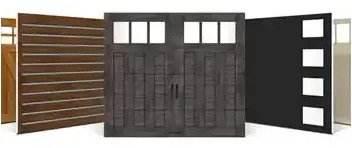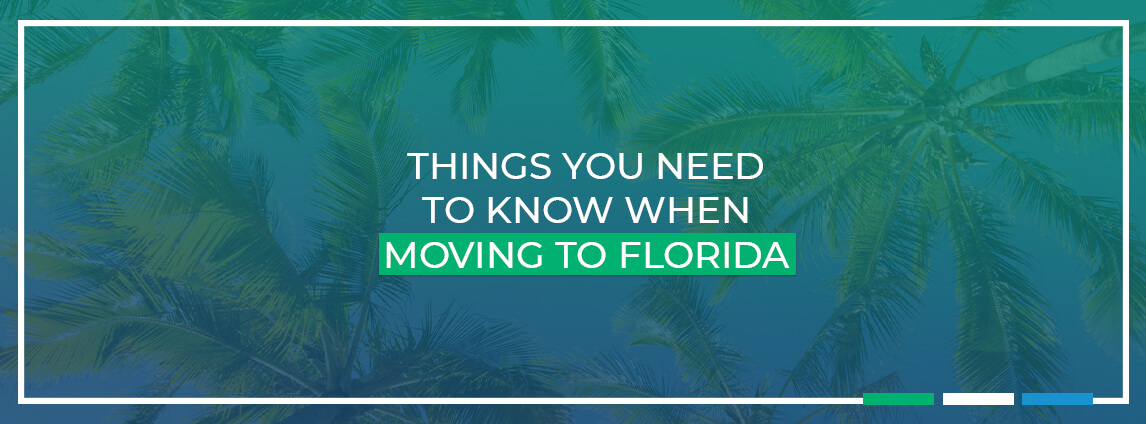
Every day, nearly 1000 people move to Florida. With a nickname like “The Sunshine State,” it’s no surprise people flock here by the thousands. If you’re planning to join that number, you should learn a bit about your future home before it’s time to unpack. From what kind of weather to expect to where to find a high-quality restaurant, it’s helpful to learn a few basic things you should know before moving to Florida.
Of course, any new place will have a few surprises. That’s part of the excitement of moving — exploring a new region and taking steps to make it feel like home. However, there are some things you may want to know before you get there to make the transition smoother and more enjoyable.
If you have your eye on the Everglade State, use this guide to gather some general intel before you move. These 13 categories will tell you what you need to know when moving to Florida.
Table of Contents
- Weather
- Wildlife
- Housing
- Cost of Living
- Insurance
- Employment
- Population
- Cuisine
- Region
- Activities
- Tourists
- Snowbirds
- Home Improvement
- Ready to Go? Keep These Moving Tips in Mind
1. Weather
Since this usually tops the list of reasons to move to Florida, let’s start with the weather. What can you expect from the weatherman in Florida? He has a tougher job than you may think. As its nickname implies, Florida offers a lot of sun and warmth — however, the weather does vary somewhat.
Most of Florida falls under a sub-tropical climate that creates long summers and short, mild winters. During the warmest part of the year, you can expect to break out your shorts and tank tops for temperatures in the 80s. You won’t need snow boots or a parka in the winter, but you may need a light jacket. Average temperatures are in the low 50s in northern Florida and the upper 60s in southern Florida.
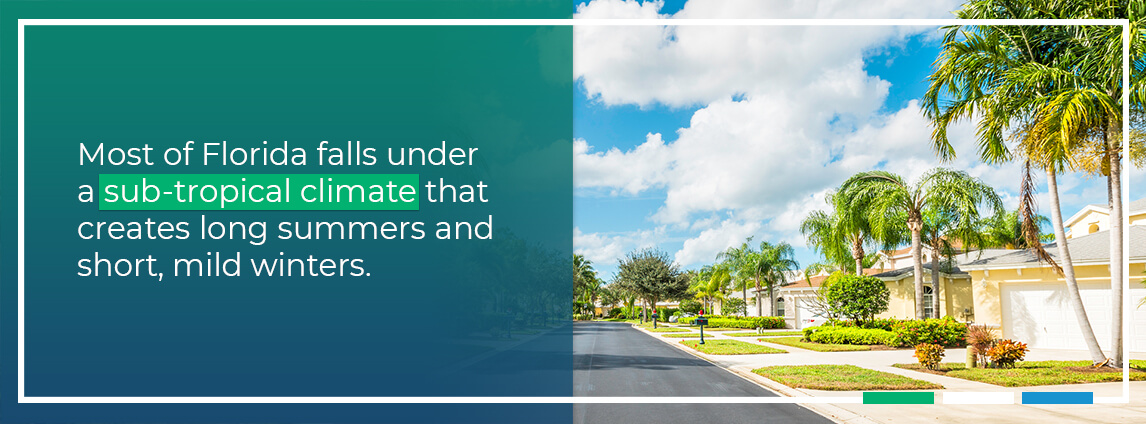
As for rain showers, Florida sees about 55 inches of precipitation a year. If you’ve visited this state in the summer, you know Floridians can usually count on a brief rainstorm each afternoon — they usually only last about 45 minutes. Learn to incorporate these into your day, and you’ll probably start to enjoy the showers and coastal breezes that cool off the peninsula in the hot afternoons.
If you’re wondering about more extreme weather, you should be aware of the potential for hurricanes. In this region, hurricane season occurs from June to November with peak time from late August through September. Each year, one or two hurricanes usually hit the east coast of the United States. Around 40 percent of them hit Florida, which has experienced 37 hurricanes since 1851.
It’s possible to live in Florida and never experience a hurricane. However, hurricane safety is one of the things to know before moving to Florida. If this region will be your new home, study hurricane safety tips so you understand what steps to take during your first severe weather alert.
2. Wildlife
While we’re discussing the outdoors, we should cover the area wildlife. What can you expect to see in your yard, at the park or at the beach? If you’re moving from a different region of the country, the creatures you encounter may be quite different than the ones in your old home town — remember, Florida is also known as “The Alligator State.”
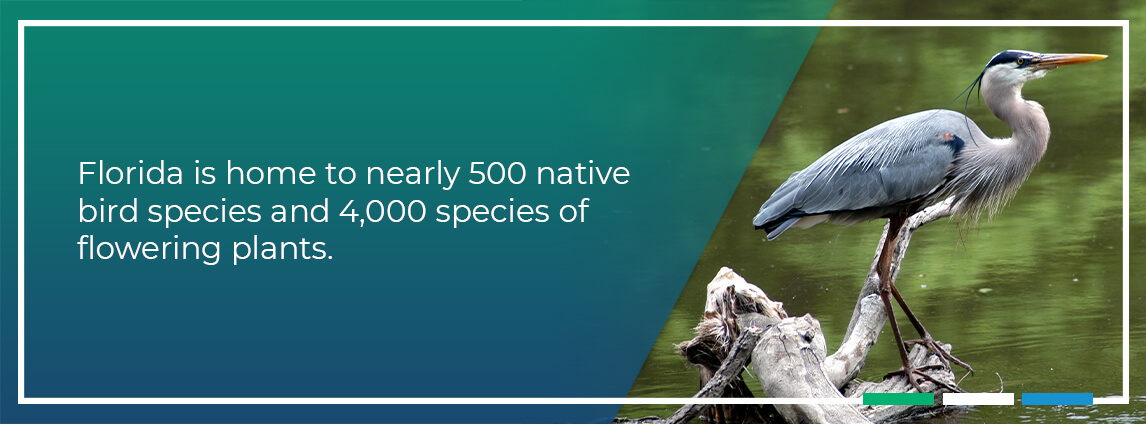
The various forms of wildlife you’ll likely encounter include:
- Land Animals: Florida’s landscape is diverse, bringing a variety of animals to your door. In Florida, you can explore everything from prairies to forests to swamps. These environments provide ideal homes for animals such as alligators, iguanas and pythons. You can also find white-tailed deer, fox squirrels, raccoons, armadillos and opossums. In certain areas, you should swim and hike with caution. Keep in mind, gators like to bask in the sun by rivers and lakes, and snakes are fond of curling up under porches.
- Aquatic Animals: In the water — and potentially on land, as well — you’ll encounter a variety of turtles, lizards and frogs. In fact, Florida offers more amphibians than any other state. If you like to fish, you’re coming to the right place. A host of freshwater lakes, rivers, tidal flats and the Atlantic Gulf stream offer great fishing spots.
- Insects: Florida’s surroundings also make the state perfect for certain pests. Palmetto bugs, flies, spiders and fire ants are among the most common crawlers. Cicadas and walking sticks might be among the insects you’re less familiar with from other regions. Since Florida offers a warm climate, bugs are common year-round. You’ll probably want to find a good exterminator when you move and keep a fly swatter or two on hand.
- Birds: Nearly 500 native bird species call Florida home, including the state bird, the Northern Mockingbird.
- Plants: If your interests lie more with plant life than animal life, you’re in luck. Florida’s subtropical climate supports nearly 4,000 species of flowering plants. Thriving in the sun, you’ll find orchids, palms and more tree species than any other state.
3. Housing
Another common list-topper of things to know about living in Florida is the housing market. Whether you will be buying a home or renting, it’s helpful to learn about housing costs and what types of dwellings are popular in the region.
Florida offers a median home value slightly higher than the national average, at $206,476. As you’d probably expect, some beachfront towns are more expensive than other parts of the state. According to Zillow estimates, the median list price for homes in Florida is $161/square foot. This site also predicts housing prices will increase 2.5 percent in the next year. If you’re considering renting, you can expect a median rent price around $1800.
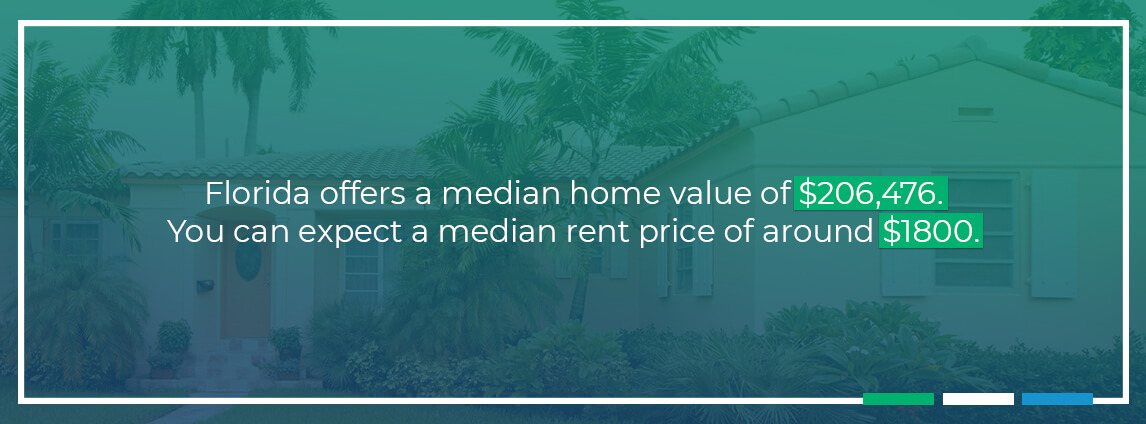
As for the style of homes, Florida is fairly eclectic. You can find everything from historic homes to modern resort-style condos. A common theme in Florida you might not see elsewhere is the Spanish or Mediterranean style. This features a tile roof, stucco walls and iron window trim. This architectural style is often associated with Florida and is usually found among higher-priced homes.
4. Cost of Living
Of course, there are other costs involved when living in Florida in addition to housing and home remodeling. Taxes, utilities, transportation and other expenses must be factored in as you set your budget for your new life in Florida.
The good news is, most living costs are comparable to other states, and some offer savings. Due to the warm weather, you can expect to spend less on heating fuel and winter clothing than in other parts of the country. The big saver, though, is state income tax — it doesn’t exist in Florida. That’s right, you don’t have to pay state taxes on your income in the Sunshine State, meaning you’ll have more money to spend on tank tops and beach accessories.
5. Insurance
Insurance is another major factor in the cost of living. An additional insurance plan to consider if you’re moving to Florida is flood insurance. Remember those storms, everglades and rivers we mentioned? They put most of Florida at a serious flood risk. Since most Florida homes are near the water, flood insurance is often a necessity.
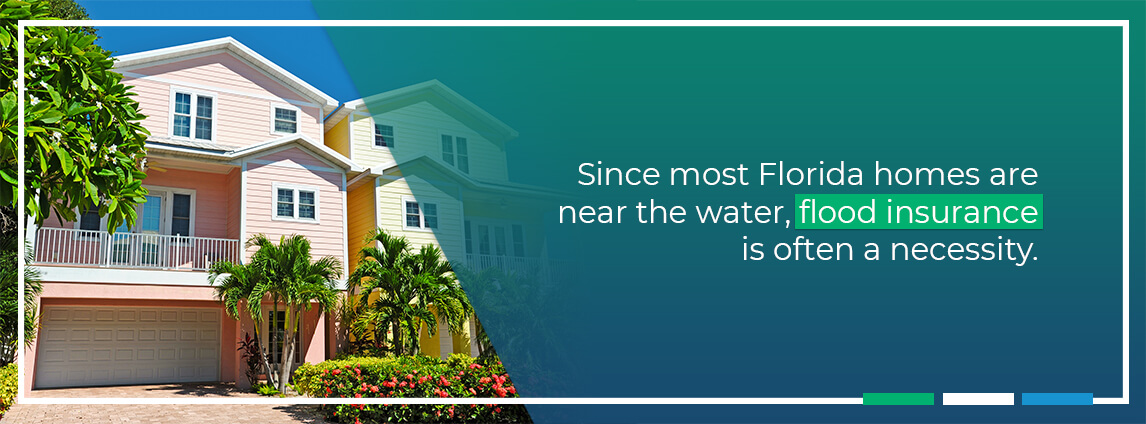
This coverage is typically required to obtain a mortgage — especially on waterfront homes — and it usually isn’t included in a homeowner’s insurance policy. So, homeowners must purchase flood insurance separately. Most flood insurance is provided through the National Flood Insurance Program, which is handled by the Federal Emergency Management Agency (FEMA).
If you are considering purchasing a specific property in Florida, verify whether you will be required to purchase flood insurance and how much it will cost. Flood insurance can be pricey and could significantly affect your monthly budget as you search for a Florida home.
6. Employment
We’ve covered much of what you will have to pay for when you move to Florida, begging the question: What employment opportunities are available in the state? It’s crucial to know how much you can expect to make, what jobs are common and what the unemployment rate is for the state.
The average Florida salary ranges from $9.21 per hour to $30.71 per hour. In November 2017, the Bureau of Labor Statistics reported Florida’s unemployment rate was 3.6 percent.
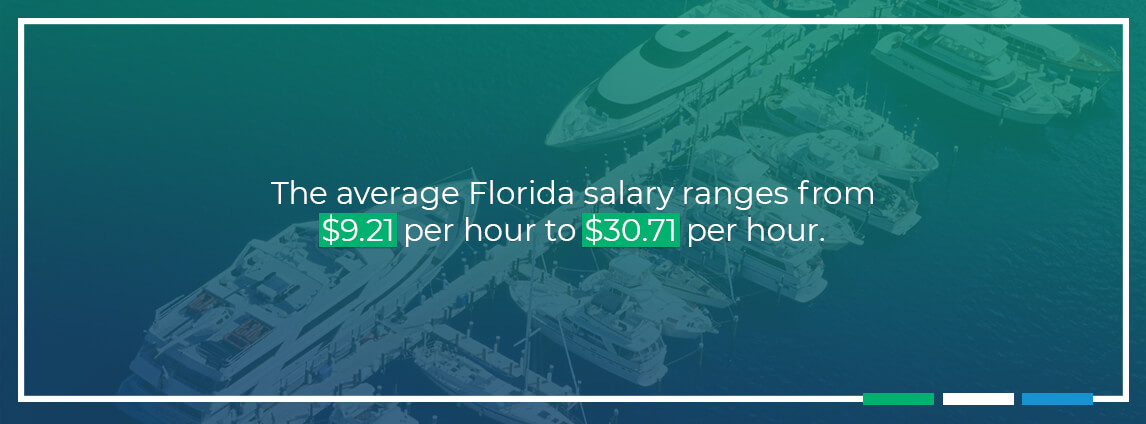
Some employment positions are more common in Florida than any other state. The top 12 jobs you’re more likely to find in Florida are:
- Commercial drivers
- Hoist and winch operators
- Construction workers
- Building cleaning workers
- Motorboat operators
- Aerospace engineering technicians
- Farm advisors
- Forensic science technicians
- Electrical technicians
- Fiberglass fabricators
- Amusement and recreation attendants
- Pest control workers
If you’re looking for growth rather than uniqueness, you might consider applying for some of the fastest-growing jobs in the state, which are:
- Statisticians
- Reinforcing iron and rebar workers
- Brick masons, stone masons and tile setters
- Nurse practitioners
- Insulation workers
- Physician assistants
- Roofers
- Cement masons and concrete finishers
Not surprisingly, Walt Disney World is one of Florida’s biggest employers. Other top employers include the public-school system, the healthcare industry and Publix supermarkets, a Florida-based grocery chain. Many Floridians also find work in the agricultural industry, due to the state’s lengthy growing season. Other popular fields of employment include exports, aviation and biomedical research.
7. Population
As you review the list of job opportunities in Florida, you may wonder who holds these positions. Floridians hail from all over the country. With a high percentage of transplants, Florida offers a mixed demographic. Despite the considerable number of seniors who retire here, the state does not have the highest median age in the U.S.
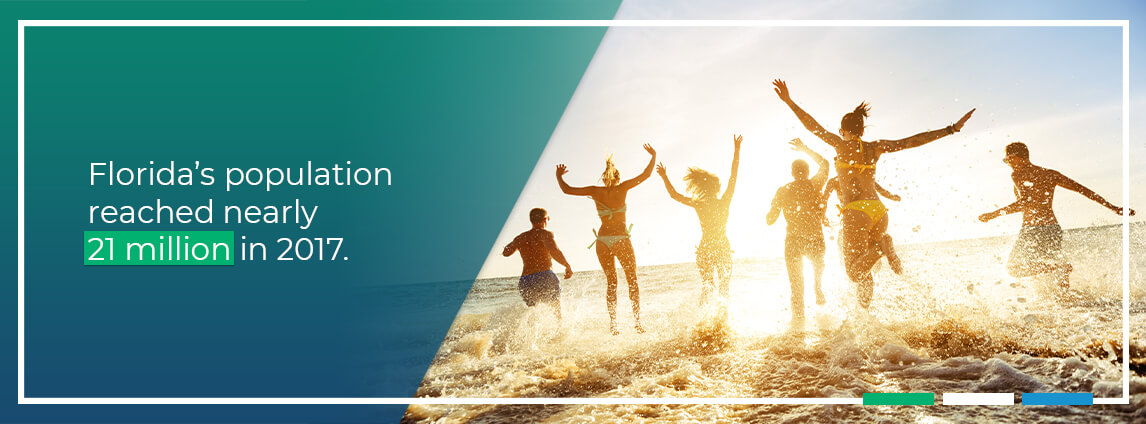
As for other demographic characteristics, Florida offers a fairly diverse landscape. The U.S. Census Bureau estimates Florida’s population reached nearly 21 million in 2017, putting the population density at 350.6 people per square mile. This population is made up of 54.9 percent white, 24.9 percent Hispanic, 2.9 percent Asian and 16.8 percent African American residents. More than 87 percent of Floridians have a high school diploma or higher-level education, and the average household is made up of 2.64 people.
8. Cuisine
If you have a picky pallet, information on the local cuisine is one of the things to know before moving to Florida.
While you don’t have to like seafood to live in this state, it helps. Nestled between the Atlantic Ocean and the Gulf of Mexico, Florida has prime access to seafood. You’ll find everything from stone crab and lobster to mahi-mahi and snapper or swordfish and clams.
Florida’s main menu selections vary based on the region of the state. Northern Florida offers mostly southern cuisine. You’ll experience the influences of Creole and Cajun cooking here. Southern Florida food selections are strongly influenced by Cuban and Caribbean menus. In the Florida Keys, you’ll find other food traditions unique to the area.
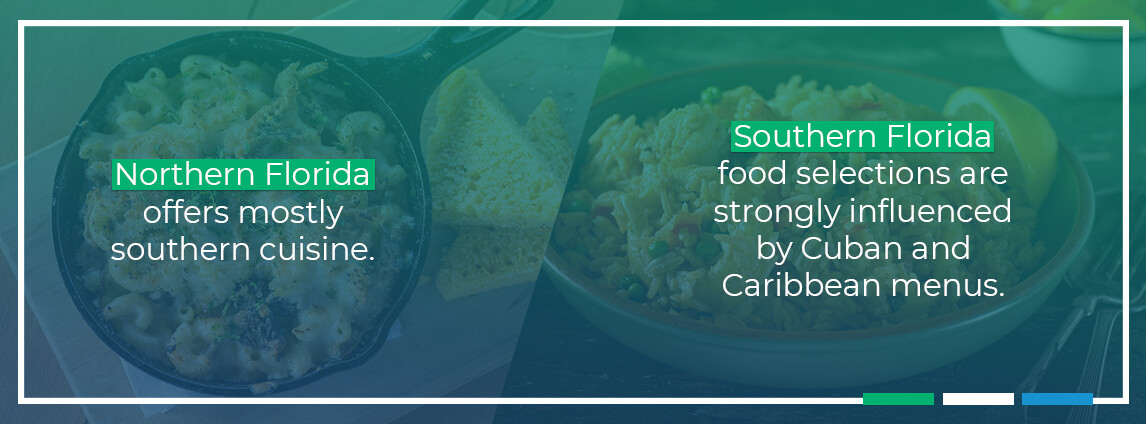
With a long growing season, all areas of Florida offer an abundance of fruits and vegetables on the menu, so you’ll probably experience more fresh produce than in other parts of the country. Another unusual item you may see on your plate? Alligator.
9. Region
These differences in cuisine bring up an important thing to know about living in Florida. Your experience living in northern Florida will probably be very different than living in Southern Florida. The culture and climate vary greatly between the two regions.
For example, northern Florida is less vulnerable to climate changes, while southern Florida offers more diversity. In the southern part of the state, you will also experience more Caribbean and Latin American influences and a more active nightlife.
10. Activities
Florida offers a plethora of outdoor activities to keep you busy year-round. In addition to gorgeous beaches for swimming, surfing, snorkeling and other water activities, the state features many rivers, springs, lakes and parks. Residents and visitors can enjoy kayaking, paddle boarding and fishing. Golf is another popular pastime — the state has many high-end courses that attract top golfers from around the country.
Of course, we can’t leave out Mickey and his pals. Walt Disney World is one of the main attractions in the state. Combined with Universal Studios, Sea World and other amusement parks around Orlando, these playgrounds for adults and kids alike are well worth at least one visit.
11. Tourists
Also among the list of things you should know before moving to Florida is the impact of tourism. In 2015, nearly 90 million Americans traveled to Florida. Another four million Canadians made the trek, as well as 11.2 million visitors from overseas — that’s a lot of tourists pouring into the Sunshine State.
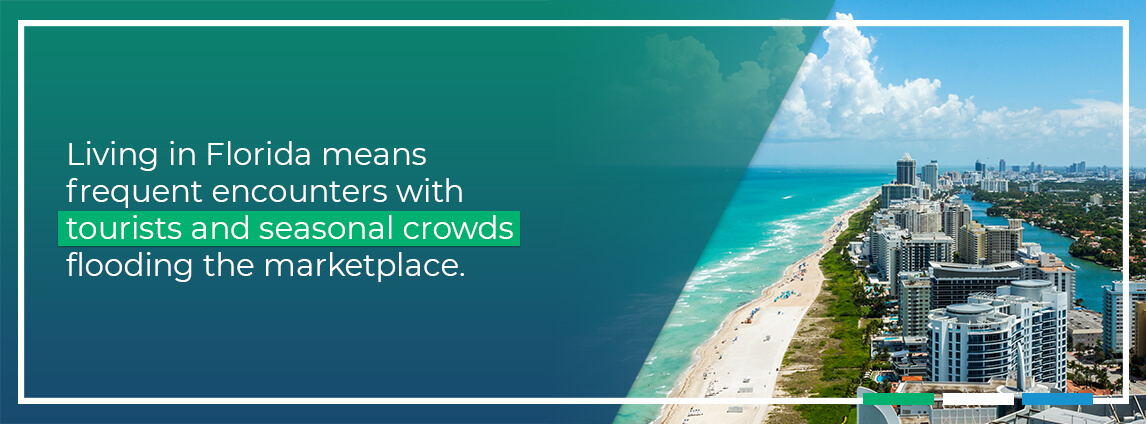
Living in Florida means frequent encounters with tourists and seasonal crowds flooding the marketplace. Keep in mind, this influx is not a terrible thing. The tourism industry keeps Florida’s economy healthy, providing jobs and boosting income throughout the state.
But, you might want to brace yourself during spring break.
12. Snowbirds
As you adjust to the coming and going of tourists, you should also be aware of snowbirds. No, these are not puffins or penguins that make their way to and from Florida. They are people who live in the state but only reside there seasonally.
Snowbirds are often retirees who migrate to the south during the winter months from their summer homes in northern locations, like Michigan, Vermont or New York. They’ll share the state with you during the warm winter weather, then they’ll be off to their homes up north once the snow melts.
13. Home Improvement
Moving often involves home improvement projects. Even if you find a place that seems perfect for your needs, you may have projects you’d like to complete to make the home your own. If you buy an older home, it can be particularly important to update its exterior and improve the functionality of the garage.
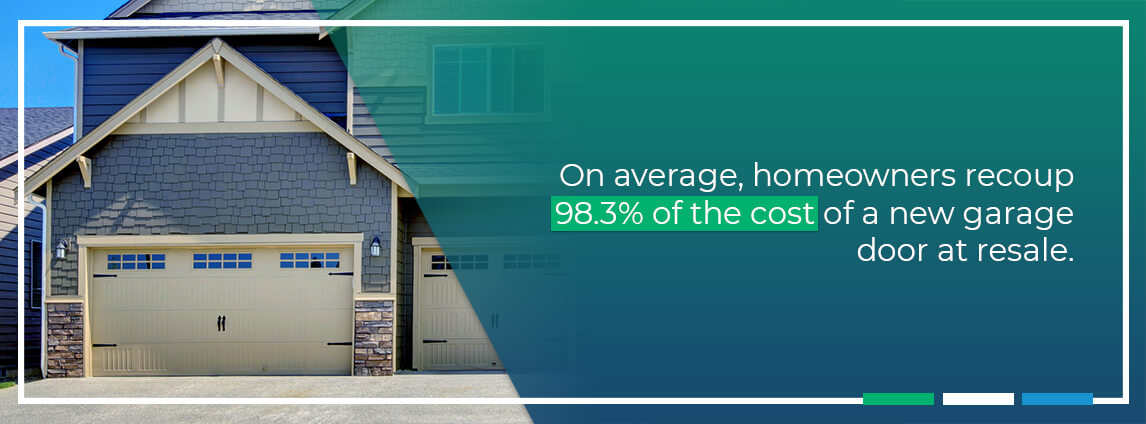
Often, homeowners overlook one project that can drastically personalize their space, improve their curb appeal and offer great ROI: a new garage door. As you review your home remodeling plans for your new space, don’t miss this opportunity. On average, homeowners recoup 98.3 percent of the cost of a new garage door at resale — that’s a better return than nearly any other home improvement project.
As you plan your garage door replacement or other home improvement projects, it’s important to find local garage door professionals you can trust to complete the work. Look for established businesses who offer experience and in-depth knowledge of their industry. For garage door experts in the Tampa Florida area, contact the professionals at Banko Overhead Doors. When you live in Florida, upgrading to a hurricane rated garage door can significantly help protect your home from hurricanes and flooding.
Ready to Go? Keep These Moving Tips in Mind
If you are planning a move to Florida, you probably have a huge to-do list in front of you. In almost any situation, moving is a major project. With a lack of organization, it can be a huge headache. But, by taking the proper steps, it can be a smooth process.
Use the following tips to make your move to Florida efficient, and maybe even enjoyable:
- Save on Supplies: If you’ll be packing your own belongings, consider using items you have on hand for packing supplies. Save on bubble wrap and tissue paper by using clothing and linens to protect your dishes. This also reduces the number of boxes you’ll need overall. Insert glasses into clean socks. Wrap plates and platters in sweaters. Use towels to wrap picture frames and fragile artwork.
- Label Everything: As you pack your boxes, clearly identify what’s inside. A simple system is to use a black permanent marker to write on the box. If you want to get a little more sophisticated, you can use color-coordinated stickers. Mark all kitchen boxes yellow and all boxes that go in the garage red, for example. As you write on the label, be specific to help with unpacking procedures. Write “plates and glasses” rather than simply “kitchen.” Also, put labels on the sides of the boxes, not the top, so you can still see them once they’re stacked.
- Use Baggies: Do you have furniture you must disassemble for the move? To keep track of the hardware, use sandwich bags. Label each baggie with masking tape and store all hardware baggies together or tape each bag to the appropriate piece of furniture — although we recommend labeling them, too, just in case.
- Take “Before” Pictures: Before you take apart your electronics, snap a picture of the wiring. Sure, you can get out the instructions to reassemble it once you move, but a picture is worth a thousand words. Do the same for furniture or anything else you have to take apart. You can even document how you’ve arranged certain décor by taking a picture to replicate in your new place.
- Prepare Documentation: Changing your address can feel overwhelming. Start by making a complete list of everyone who will need your new address. Begin notifying vendors three weeks before your move. Don’t forget the utility companies at both locations, the post office, subscription services, the bank, your employer and your friends and family. Additionally, make a note to get a new drivers license once you arrive in Florida.
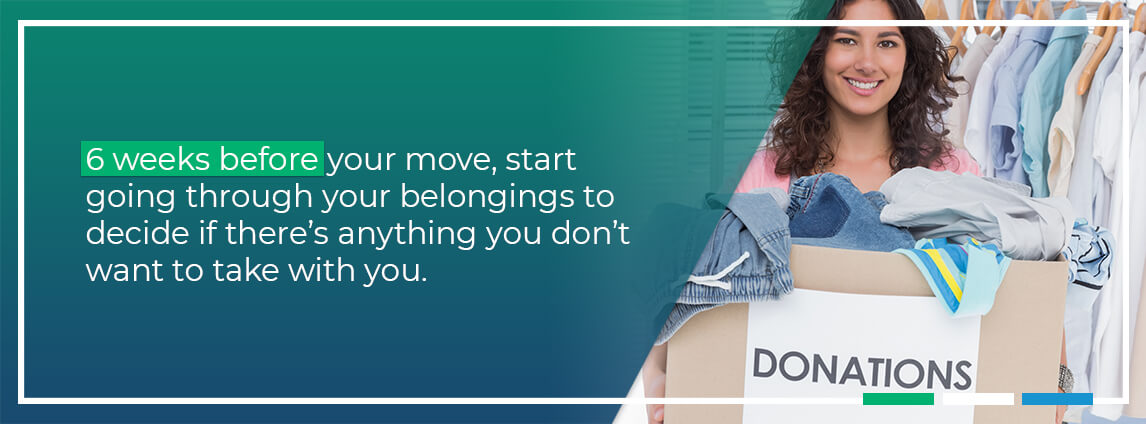
- Donate, Sell and Give Away Items: Six weeks before your move, start going through your belongings to decide if there’s anything you don’t want to take with you. Sort things into piles to be donated, sold or given to friends and family. If you’re moving from a colder climate, keep in mind you’ll no longer need an extensive winter wardrobe. If anyone is helping you move, you might consider offering your goodies to them first. If you’re selling items on eBay or Craigslist, give yourself plenty of time to sell them before the day of the move.
- Pack an Emergency Kit: For moving day, pack a bag with all the essentials. This should include a change of clothes, your toiletries, important documentation and financial items, a cell phone charger and anything else you can’t live without for a few days. Keep this with you as you travel to your new home.
- Plan for Projects: If you have home remodeling projects planned for your new home in Florida, try to make arrangements for these before you move. Many projects are easier to complete before furniture and boxes arrive. If updating your garage door is on your list and you are in the greater Tampa Bay area, contact the experts at Banko Overhead Doors. Our professionals will make your new home more inviting with a gorgeous new garage door to greet you.
Now that you’ve learned many of the things you should know before moving to Florida, focus on enjoying the transition and getting excited for everything The Sunshine State has to offer!
Additional Resources on Garage Doors in Florida:
- Popular Types of Homes in Florida
- How to Buy Rental Property in Orlando, Florida
- Tips for Moving to Orlando, Florida










